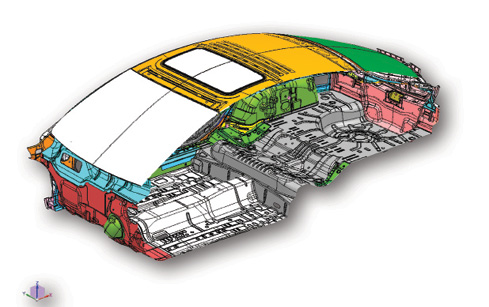
Section view of vehicle body and air cavity geometry of the automotive vehicle coupled structure/acoustic model used for the benchmark.
Latest News
October 1, 2017
 Once a relatively obscure role focused on independent study, the computer-aided engineering specialist has become a highly sought-after asset. Engineering organizations have ramp ed up their simulation efforts to boost product innovation and have become more competitive. The expanded focus has fueled a flurry of investment in new CAE analyst hires, but the number of on-staff simulation experts still pales in comparison to the broader engineering and design community.
Once a relatively obscure role focused on independent study, the computer-aided engineering specialist has become a highly sought-after asset. Engineering organizations have ramp ed up their simulation efforts to boost product innovation and have become more competitive. The expanded focus has fueled a flurry of investment in new CAE analyst hires, but the number of on-staff simulation experts still pales in comparison to the broader engineering and design community.


The limited number of CAE specialists is highly valued, not just for their in-depth knowledge of finite element analysis (FEA) and computational fluid dynamics (CFD), but also for their expertise in more specialized analysis and multiphysics domains. With only so many CAE experts to go around, engineering organizations are challenged to embrace new ways of working that can help propagate this rich source of intellectual capital throughout the engineering ranks and over the course of the complete design lifecycle.
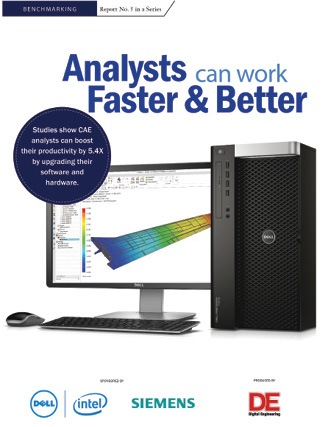 Free Download: Benchmarking Report 5: Analysts Can Work Faster & Better via digitaleng.news/de/benchmark5
Free Download: Benchmarking Report 5: Analysts Can Work Faster & Better via digitaleng.news/de/benchmark5The Struggle for Efficiency
In reality, most engineering organizations are still struggling to optimize their limited CAE resources. Research shows there can be as many as 10 CAD designers for every dedicated CAE expert, each vying for specialists’ input and analysis results in a timely manner. The pumped up demand has created a serious simulation bottleneck, causing frustration for design engineers, who are forced to put projects on hold as they await analyst feedback, and also among the CAE experts who are overworked and pulled in too many directions.
There are other pain points surrounding the simulation workflow, particularly for CAE experts. With model sizes and complexity on the rise, CAE analysts are spending more time on each modeling task, limiting their ability to tackle additional simulation work. In a similar vein, the simulation studies themselves are more in-depth, many demanding multidisciplinary analysis and complex meshing strategies. The time-consuming nature of the work is limiting the number of simulation studies and design iterations while also requiring experts to labor over tedious model setup, as opposed to high-value work like more advanced simulations and defining and promoting analysis best practices.
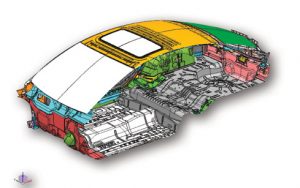 Section view of vehicle body and air cavity geometry of the automotive vehicle coupled structure/acoustic model used for the benchmark.
Section view of vehicle body and air cavity geometry of the automotive vehicle coupled structure/acoustic model used for the benchmark.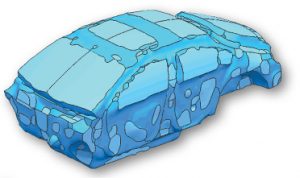
The struggle to efficiently leverage highly skilled CAE talent creates a domino effect throughout the product development cycle. CAE experts work on fewer, more complex simulations, vastly impeding an organization’s ability to fully explore design options and home in on the best designs. In addition to undercutting the widespread use of simulation, the bottleneck makes it harder for analysis results to have a lasting impact on critical design decisions. For example, a longer than average analysis cycle can produce results that are too late or out of sync with the latest design iteration, undermining the chance of proper optimization.
Break the Bottleneck
The good news is that there are a number of ways to break the bottleneck and achieve faster, highly integrated and effective simulation. Taking advantage of the latest simulation software can go a long way toward making analysis capabilities more accessible to design engineers, shifting some of the burden away from dedicated CAE specialists and promoting analysis-led design as a mainstream best practice. Faster solvers provide simulation results faster, enabling their use in critical decision making. In addition, integrated CAD/CAE platforms with open programming environments can provide a boost by capturing and automating simulation best practices, once again reducing dependence on CAE experts for every simulation function.
The Results: Old vs. New
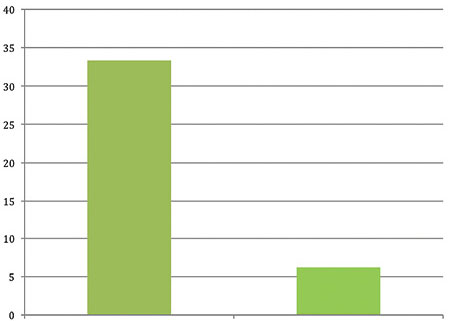 Using NX Nastran 11 on modern hardware provided a 5.4X speed improvement when solving the smaller model vs. using NX Nastran 9 on the three-year-old workstation. The older workstation could not complete the medium-size model simulation.
Using NX Nastran 11 on modern hardware provided a 5.4X speed improvement when solving the smaller model vs. using NX Nastran 9 on the three-year-old workstation. The older workstation could not complete the medium-size model simulation.Upgrading to the latest hardware can also significantly help speed up simulation. Workstations equipped with state-of-the-art, multi-core processors, solid state drives (SSDs) and ample memory, among other enhancements, can dramatically boost simulation software performance and drive efficiencies throughout the analysis lifecycle. A workstation calibrated for simulation can break the logjam, allowing analysts to perform complex modeling work and explore more design possibilities throughout the design lifecycle.
Deploying state-of-the-art hardware and CAE software not only ensures simulations run faster, it also introduces the possibility of greater design exploration via more advanced, multiphysics analysis and more detailed and complex models. With a simulation platform tuned for optimal performance, CAE experts are empowered to explore more design possibilities more frequently throughout the process without taking their workstations offline for hours at a time and freeing up bandwidth to juggle multiple modeling requests. For example, our benchmark tests show the latest version of Siemens’ NX Nastran (version 11 was used in this study; Siemens will be releasing version 12 in the coming weeks) on a state-of-the-art modern workstation will run some simulations up to 5.4X faster than on a comparable hardware-software setup from three years ago.
Siemens PLM Software, along with partners Intel and Dell, collaborated with Digital Engineering to explore the impact of outdated software and hardware on present-day simulation studies. The partners conducted a benchmark study to test vendor claims that state-of-the-art hardware and simulation software upgrades can dramatically bolster the performance of simulation-driven design and optimization.
Download the full benchmarking report at digitaleng.news/de/benchmark5.
Subscribe to our FREE magazine, FREE email newsletters or both!
Latest News






